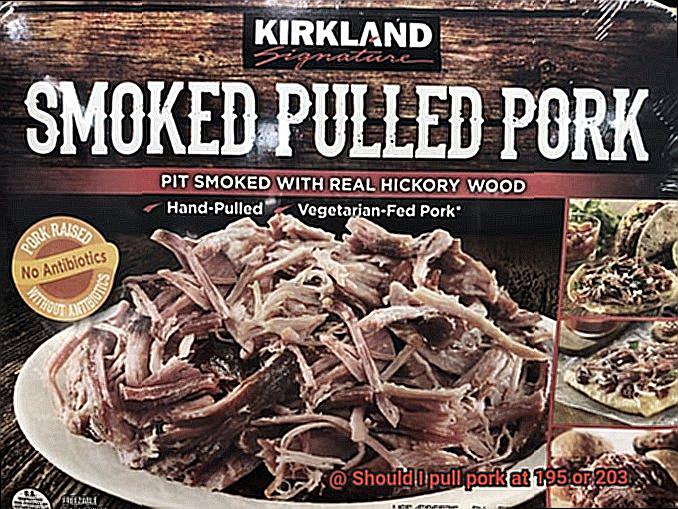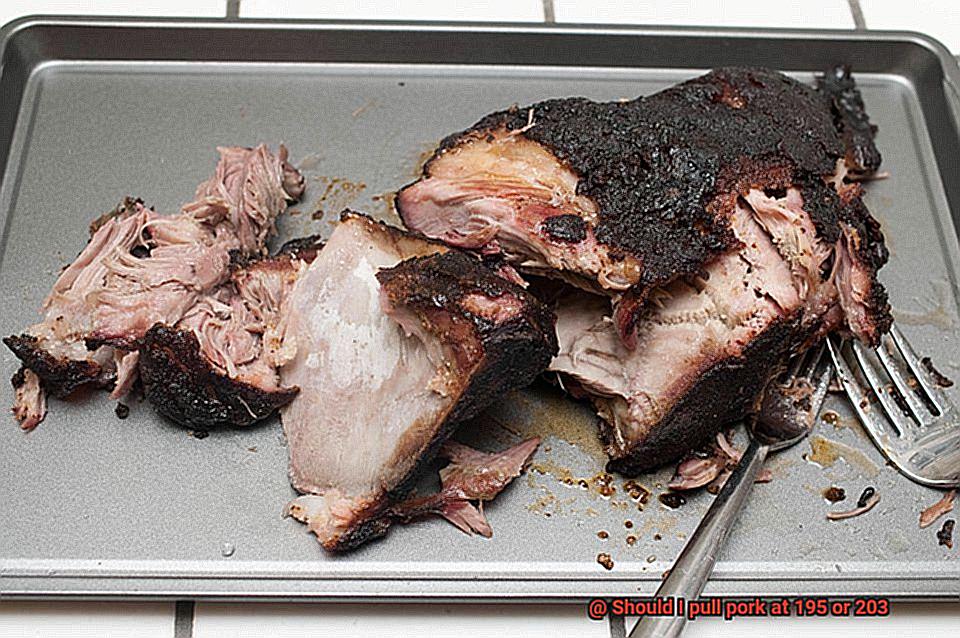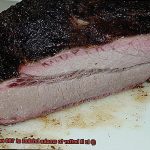Title: The Great Debate: Should I Pull Pork at 195°F or 203°F?
Contents
Introduction:
Love BBQ? Then you’ve probably wondered, should I pull my pork at 195°F or 203°F? It’s a simple question with a not-so-simple answer. This culinary conundrum has sparked fiery debates among BBQ lovers, from amateurs to experts. Some swear by 195°F, claiming it creates the juiciest, most tender pulled pork. Others argue passionately for 203°F, promising unrivaled succulence and flavor.
Let’s dive into this debate and explore both sides of the spectrum to understand why people choose one temperature over the other.
On one hand, pulling pork at 195°F is the go-to choice for many pitmasters. At this temperature, the meat is perfectly moist and effortlessly shreddable. It’s reached that sweet spot where fat and connective tissues have rendered enough to achieve desired tenderness. Plus, cooking time is shorter, making it ideal for home cooks seeking quicker results. For those who prefer an easygoing approach, pulling at 195°F consistently delivers tender and juicy pork that satisfies most palates.
On the other hand, there’s a faction advocating for pulling pork at 203°F. These enthusiasts claim it unlocks a whole new level of flavor and tenderness. Though the extra 8 degrees may seem insignificant, they argue that meat at 203°F has had more time to break down connective tissues. The result? Pork so succulent and fall-apart tender that it defies belief. Collagen breakdown reaches its pinnacle at this higher endpoint temperature, delivering a melt-in-your-mouth experience beyond what you get at 195°F.
Ultimately, whether you choose to pull pork at 195°F or 203°F depends on personal preference and desired texture. To find your perfect match, embark on a tasting journey of your own—experiment with both temperatures and let your taste buds be the guide.
In the following sections, we’ll delve into the science behind these temperature thresholds, their impact on flavor, and the different cooking methods associated with each endpoint. Whether you’re a backyard BBQ enthusiast or a seasoned pro seeking new flavor nuances, join us as we explore this tantalizing debate. Get ready to elevate your pork-pulling game.
What is Pulling Pork?

This mouthwatering dish is a staple in barbecue culture, known for its tender, juicy texture and rich flavors. But what exactly is pulling pork, and how can you achieve the perfect pulled pork at home? In this article, we’ll dive into the world of pulling pork, exploring the technique and discussing the age-old debate of whether to pull at 195 or 203 degrees Fahrenheit.
The Process of Pulling Pork:
- Slow Cooking: Pulled pork starts with a well-seasoned pork shoulder or butt. Before pulling, the meat needs to be slow-cooked over low heat for several hours until it reaches an internal temperature of 195 to 203 degrees Fahrenheit. This low and slow cooking method allows the fat and connective tissues to break down, resulting in tender and flavorful meat.
- Shredding the Meat: Once the pork is fully cooked, it’s time to pull it apart. Using two forks or other utensils, start shredding the meat into smaller, bite-sized pieces. The act of pulling apart the meat fibers creates a texture that’s both tender and juicy, giving pulled pork its distinct appeal.
The Great Temperature Debate:
- Pulling at 195°F: Advocates of pulling pork at 195 degrees Fahrenheit argue that this lower temperature retains more moisture in the meat, resulting in a juicier end product. They believe that pulling at a higher temperature can lead to dry and overcooked meat.
- Pulling at 203°F: On the other hand, supporters of pulling pork at 203 degrees Fahrenheit believe that this higher temperature is necessary to fully break down the connective tissues in the meat. They argue that it yields a more tender and melt-in-your-mouth consistency.
Tips for Achieving Perfect Pulled Pork:
- Experiment: The choice of pulling pork at 195 or 203 degrees Fahrenheit ultimately depends on personal preference. To find your ideal temperature, it’s recommended to experiment with both and see which one yields the desired results for your taste.
- Monitor Internal Temperature: Regardless of the temperature you choose, it’s crucial to monitor the internal temperature carefully during the cooking process. Use a reliable meat thermometer to ensure the pork reaches the desired temperature for safe consumption.
- Resting Period: After pulling the pork, allow it to rest for a few minutes. This resting period allows the flavors to meld and the juices to redistribute within the meat, resulting in a more flavorful and moist end product.
The Debate over the Ideal Temperature for Pulling Pork
Let’s dig deeper into this sizzling showdown and explore the contrasting viewpoints.
Advocates for pulling pork at 195 degrees argue passionately that this temperature preserves the meat’s moisture and tenderness. To them, anything higher risks creating dry, tough strands of meat. Scientific studies have even shown that cooking pork to an internal temperature of 195 degrees Fahrenheit helps retain the succulence by preserving its natural fats.
However, proponents of pulling pork at 203 degrees have a different perspective, one that revolves around collagen breakdown. Collagen, a protein found in connective tissue, becomes a tenderizing force during cooking. By reaching the higher temperature, the collagen breaks down further, resulting in an explosion of succulence and flavor. Settling for a lower temperature could leave certain parts of the meat undercooked and frustratingly chewy.
But hold on just a moment. Before you pick your temperature side, there are crucial factors to consider. The specific cut of meat and cooking method play pivotal roles. Different pork cuts possess varying levels of fat and connective tissue, which significantly affect the ideal temperature for achieving mouthwatering tenderness. And let’s not forget about the cooking method itself. Low and slow cooking, like in a smoker, may demand a higher temperature to ensure thorough cooking and collagen breakdown. In contrast, pork cooked at higher temperatures on a grill or in an oven might benefit from being pulled at a slightly lower temperature.
Ultimately, deciding whether to pull pork at 195 or 203 degrees rests in personal preference and fearless experimentation. It is highly recommended to explore both temperatures and experience their distinct results in terms of tenderness, juiciness, and flavor. And remember the importance of the resting period after pulling the pork – granting it about 30 minutes to redistribute its precious juices, ensuring a harmonious moisture distribution throughout.
Pros and Cons of Pulling Pork at 195°F
Get ready for the ultimate pulled pork showdown. Today, we’re diving headfirst into the fiery debate of pulling pork at 195°F versus 203°F. So grab your grilling gloves and prepare for a smoking hot discussion.
Let’s start with the pros of pulling pork at 195°F. First up, we have tenderness. At this temperature, the connective tissues in the meat have broken down to perfection, resulting in a melt-in-your-mouth texture that will leave you weak at the knees. Say goodbye to tough and chewy pork, and hello to a juicy and tender masterpiece.
Speaking of juicy, pulling pork at 195°F ensures that your meat stays moist and flavorful. The fat has had ample time to render and distribute throughout the meat, giving it that succulent taste that we all crave. Whether you’re making sandwiches or a classic pulled pork dish, you can count on that mouthwatering juiciness that will have your guests coming back for seconds.
But what about time? We all know that when it comes to grilling, every minute counts. Well, pulling pork at 195°F has a leg up in this department too. Compared to pulling at 203°F, the cooking time is relatively shorter. That means you can serve up your delicious creation to your hungry crowd just a little bit faster. And let’s be honest, who doesn’t love saving some precious minutes when it comes to grilling?
Now, let’s turn up the heat on the cons of pulling pork at 195°F. One potential downside is that the meat might not be as fully tenderized compared to when pulled at 203°F. While it will still be tender and delicious, some purists argue that a slightly higher temperature allows for an even better breakdown of collagen, resulting in an even more succulent final product. So if you’re really looking to blow your taste buds away, you might want to consider cranking up the heat a few degrees.
Another drawback of pulling pork at 195°F is that it leaves less margin for error. If you accidentally overshoot the desired temperature, your meat could become dry and overcooked. We all know that one minute can make all the difference when it comes to grilling, so keep a close eye on that thermometer to avoid any culinary mishaps.
Lastly, certain cuts of pork may benefit from being pulled at a higher temperature. For example, Boston butt or pork shoulder, which are commonly used for pulled pork, have a lot of connective tissue that requires more time and heat to break down completely. Pulling these cuts at 203°F ensures that every bit of meat is thoroughly tenderized and results in a more consistent texture throughout.
Pros and Cons of Pulling Pork at 203°F
Get ready for a sizzling debate that will leave your taste buds weak at the knees. Today, we are diving into the battle of pulling pork at 203°F versus the traditional 195°F. As an expert in all things grilling, I’m here to break down the pros and cons of this controversial cooking temperature. So, grab a seat, because this showdown will have you rethinking your pulled pork game.
Pros of pulling pork at 203°F:
Enhanced tenderness:
Cooking pork to a higher internal temperature, such as 203°F, allows the collagen and connective tissues in the meat to break down further. This results in a more tender and melt-in-your-mouth texture, making it easier to pull apart. Imagine sinking your teeth into succulent pork that practically melts in your mouth – pure bliss.
Improved flavor development:
The longer cooking time required to reach 203°F allows for more flavor development. As the pork cooks slowly, it has more time to absorb and incorporate the flavors from rubs, marinades, or smoke. This can lead to a more flavorful and well-seasoned end product. Picture a symphony of smoky, spicy, and sweet flavors dancing on your palate – irresistible.
Increased juiciness:
By cooking pork to a higher temperature, the fat within the meat has more time to render and distribute throughout the muscle fibers. This can result in a juicier final product, as the fat helps retain moisture and prevents dryness. Say goodbye to dry and flavorless pulled pork – hello juicy perfection.
Easier shredding:
Pulling pork at 203°F can make the shredding process easier, as the meat tends to be more tender and falls apart effortlessly. This is particularly beneficial when preparing pulled pork sandwiches or tacos, as the meat will have a desirable texture for these types of dishes. Say goodbye to struggling with tough meat and hello to effortless shredding.
Cons of pulling pork at 203°F:
Longer cooking time:
Cooking pork to a higher temperature requires a longer cooking time compared to lower temperatures like 195°F. This can be a drawback if you’re short on time or need to prepare the meal quickly. However, the additional time can be well worth the wait for those seeking ultimate tenderness and flavor.
Potential risk of overcooking:
There is a fine line between perfectly cooked and overcooked pork when aiming for 203°F. If not monitored closely, the meat can become dry and lose its desired texture. It’s crucial to use a reliable thermometer and keep an eye on the internal temperature to avoid overcooking. Attention to detail is key.
Variability in results:
Different cuts of pork may require different cooking times and temperatures to achieve optimal results. While pulling pork at 203°F may work well for some cuts, it may not be ideal for others. It’s essential to consider the specific cut and adjust the cooking temperature accordingly. One size does not fit all.
Loss of bark texture:
The longer cooking time required to reach 203°F can affect the texture of the pork’s outer crust, known as the bark. At higher temperatures, the bark may become softer and less crispy compared to lower temperature cooking methods. This can impact the overall mouthfeel and presentation of the dish. However, some individuals prefer a softer bark texture, which adds a pleasant contrast to the tender meat.
Factors to Consider When Deciding Between 195°F or 203°F
The decision between pulling pork at 195°F or 203°F is one that can make all the difference in achieving that tender, juicy, and flavorful result you desire. So, grab your tongs and let’s dive into the key factors you need to consider to make the right choice for your grilling adventures.
First and foremost, let’s talk about texture. Pulling the pork at 195°F will give you tender and juicy meat with a slightly firmer texture. If you enjoy a bit of bite in your pulled pork, this temperature is your go-to. On the other hand, if you want your pork to practically dissolve in your mouth, pulling it at 203°F is the way to go. This higher temperature breaks down the collagen in the meat even further, resulting in a fall-apart consistency that will leave you weak at the knees.
Next up, cooking time. Pulling the pork at 195°F generally takes less time compared to pulling it at 203°F. This can be advantageous if you’re short on time or simply can’t wait any longer to sink your teeth into that deliciousness. However, keep in mind that cooking times may vary depending on factors such as the size of the pork shoulder and your choice of smoker or grill.
Of course, personal preference also plays a crucial role here. Everyone has their own idea of what makes the perfect pulled pork. That’s why it’s worth experimenting with both temperatures to find that sweet spot that leaves you and your taste buds in pure bliss. Additionally, different cuts of pork may respond differently to various cooking temperatures, so consider that as well.
Once you’ve reached your desired temperature, don’t rush into shredding that pork just yet. Give it some time to rest and let those juices redistribute for maximum flavor. Whether you’ve pulled it at 195°F or 203°F, a 20-30 minute resting period is recommended to ensure you’re savoring every last bit of deliciousness.
Lastly, let’s not forget about the external factors. The type of smoker or grill you’re using and the ambient temperature can affect the cooking process. Different smokers or grills may have variations in temperature control, so make sure to adjust accordingly. And if you’re grilling in colder weather conditions, it may take longer for the pork to reach the desired temperature. Patience is key.
Collagen Breakdown and Carryover Cooking
Now, we’re diving into the fascinating science behind collagen breakdown and carryover cooking to help you make the best decision for your taste buds.
Let’s start with collagen breakdown. Collagen is a protein found in connective tissues that gives structure to meat. When heated, collagen undergoes a magical transformation known as denaturation. It unravels and breaks down into gelatin, resulting in tender, succulent meat. This process begins around 160 to 170 degrees Fahrenheit and continues until the meat reaches about 195 degrees Fahrenheit. At this temperature, most of the collagen has broken down, leaving you with a melt-in-your-mouth texture.
But wait, there’s more. Some experts argue that pulling pork at 203 degrees Fahrenheit allows for even further collagen breakdown and an even more tender final product. So, if you’re all about that fall-apart goodness, this might be the temperature for you.
Now let’s talk about carryover cooking. When you remove pork from the heat source, it continues to cook due to residual heat trapped within the meat. This phenomenon is called carryover cooking. It’s like getting a bonus round of cooking without even trying. The internal temperature of the meat can rise by a few degrees during this time.
So how does carryover cooking affect your decision? Well, if you pull your pork exactly at 195 degrees Fahrenheit, the carryover cooking might push it slightly higher, resulting in a firmer texture than desired. On the other hand, if you pull it at 203 degrees Fahrenheit, the carryover cooking will bring it to the sweet spot of tender, fall-apart goodness.
Tips for Perfectly Pulled Pork Every Time
Are you ready to take your grilling skills to the next level? If so, mastering the art of pulled pork is a must. But how do you achieve that perfect, tender, melt-in-your-mouth texture every time? We’ve got you covered with these expert tips for achieving perfectly pulled pork:
Start with the Right Cut
The key to great pulled pork begins with selecting the right cut of meat. The most commonly used cuts for pulled pork are the shoulder or the butt. These cuts have a higher fat content, which helps keep the meat moist and tender during the long cooking process.
To ensure maximum flavor and tenderness, choose a well-marbled piece of pork shoulder or butt. The marbling will melt during cooking and infuse the meat with rich flavors and moisture.
Seasoning is Key
Before cooking, make sure to season your pork well. A simple rub made with a combination of salt, pepper, paprika, garlic powder, and brown sugar can enhance the flavor of the meat. Be sure to coat the pork evenly with the rub and let it sit in the refrigerator for at least a few hours or overnight to allow the flavors to penetrate.
The seasoning acts as a flavor enhancer and forms a delicious crust on the outside of the meat. For an extra kick of flavor, you can also add spices like cumin, chili powder, or smoked paprika to your rub.
Low and Slow Cooking
When it comes to cooking pulled pork, low and slow is the key. This means cooking the meat at a low temperature for a long period of time. Most experts recommend cooking pulled pork at around 225-250°F (107-121°C). This allows the fat to render slowly and melt into the meat, resulting in a moist and flavorful end product.
The low and slow cooking method allows the collagen in the meat to break down, resulting in tender and juicy pulled pork. This process can take anywhere from 8 to 12 hours, depending on the size of the cut and the cooking temperature.
Internal Temperature
To achieve that perfect tenderness, you’ll need to cook the pork until it reaches an internal temperature of around 195-203°F (90-95°C). At this temperature range, the collagen in the meat breaks down, making it easier to pull apart. However, there is some debate among experts about whether to pull at 195 or 203°F.
Cooking the pork to an internal temperature of 195°F will result in slightly firmer meat that holds its shape better. This can be advantageous if you’re planning to slice the pork or if you prefer a more textured texture. On the other hand, pulling at 203°F will yield meat that is incredibly tender and falls apart easily. This is ideal if you want that classic melt-in-your-mouth pulled pork consistency.
Rest and Pull
Once the pork reaches the desired internal temperature, it’s important to let it rest. This allows the juices to redistribute throughout the meat, resulting in a more flavorful end product. Wrap the pork tightly in aluminum foil and let it rest for at least 30 minutes, but preferably up to an hour. After resting, use two forks or your hands to gently shred the meat into small, bite-sized pieces.
The resting period allows the flavors to develop further and ensures that each bite of pulled pork is moist and succulent. Shredding the meat while it’s still warm makes it easier to pull apart and creates those tantalizing strands of tender pork.
4-G7L0zIkjs” >
Conclusion
When it comes to the question of whether to pull pork at 195 or 203, there are a few factors to consider. While some argue that pulling at 195 results in a more tender and juicy meat, others swear by the magic number of 203 for that perfect texture and flavor. Ultimately, the decision depends on your personal preference and desired outcome.
Pulling pork at 195 degrees Fahrenheit allows for a slightly firmer texture, with noticeable strands of meat that hold their shape. This can be ideal if you’re looking for slices of pork that maintain their integrity on a sandwich or platter. The lower temperature also ensures that the meat retains more moisture, resulting in a juicier bite.
On the other hand, pulling pork at 203 degrees Fahrenheit takes it to another level. At this temperature, the connective tissues and collagen in the meat have fully broken down, resulting in an incredibly tender and succulent final product. The meat practically falls apart with each bite, making it perfect for pulled pork sandwiches or tacos where melt-in-your-mouth goodness is paramount.
It’s important to note that these temperatures are not set in stone. Every piece of pork is different, and factors such as size, fat content, and cooking method can all affect how it cooks and reaches its ideal doneness. So while 195 or 203 may serve as general guidelines, trust your instincts and use them as starting points rather than hard rules.
In conclusion, whether you choose to pull pork at 195 or 203 ultimately depends on your personal taste preferences and desired outcome. Both temperatures have their merits – from firm slices to melt-in-your-mouth tenderness – so experiment with both and find what works best for you.






